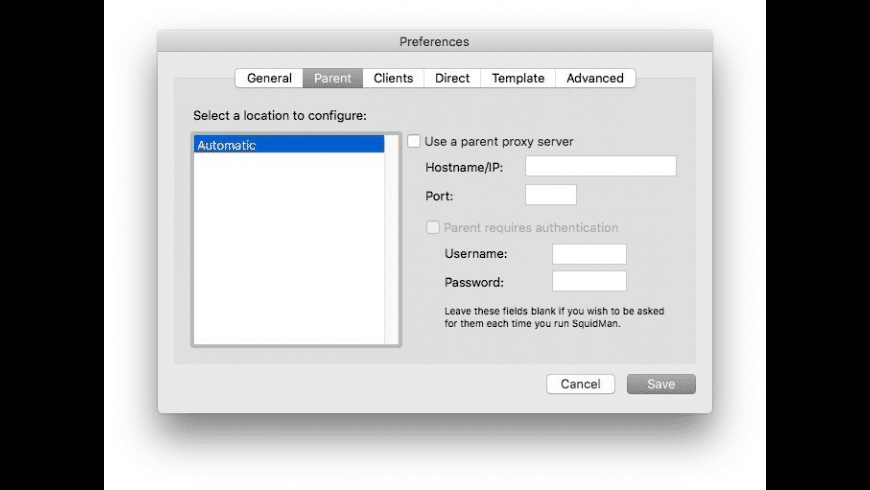Super SquidGhostMan Mac OS
- Super Squidghostman Mac Os Catalina
- Mac Os Mojave
- Super Squidghostman Mac Os X
- Super Squidghostman Mac Os 7
- Mac Os Catalina
SquidMan is a MacOS X graphical installer and manager for the Squid proxy cache. It is designed to operate as a 'personal' proxy server. When you run Squid on a MacOS X computer, it can: cache downloaded content, reducing network traffic and improving browsing performance on slow links. Mac service and repair. Learn about AppleCare+ and the Apple limited warranty coverage, start a service request for your Mac, and find out how to prepare your Mac for service. SquidMan is a Mac OS X graphical installer and manager for the Squid proxy cache. It is designed to operate as a 'personal' proxy server. When you run Squid on a MacOS X computer, it can: cache. Mar 26, 2008 Hacker Super Bowl pits Mac OS vs. By Robert McMillan. Macworld Mar 26, 2008 9:03 pm PDT. It’s the most anticipated matchup in the hacker world: Linux versus Mac OS X versus Vista.
About SquidMan
SquidMan is a MacOS X graphical installer and manager for the Squid proxy cache. It is designed to operate as a 'personal' proxy server.When you run Squid on a MacOS X computer, it can:
- cache downloaded content, reducing network traffic and improving browsing performance on slow links
- act as a proxy server for other computers on your subnet
- restore the operation of some MacOS X applications that normally fail through authenticated proxy servers
What's new - Announcing SquidMan 4.2 (November 15, 2020)
I'm pleased to announce the release of version 4.2 of SquidMan.This version is bundled with Squid 4.13. Other changes include the following:
- now a universal app that supports Apple Silicon and Intel on Big Sur
If you're upgrading from a (much!) older version of SquidMan, note that some of the values in the template used by older versions of SquidMan are incompatible with newer versions of Squid, and will generate errors or at least warnings when Squid is started. Thus SquidMan 3.8 and higher will need to replace the template file. If you have ever modified the template to add your own customisations, your changes will be lost during the upgrade. If you have modified the template from the default, be sure to save the old template before upgrading to the latest version of SquidMan. After the upgrade, you will need to manually merge your changes back into the new template.
Helper Tool Issue
If you see a message indicating that there was a problem communicating with or installing the helper tool, open the terminal, and enter the following two commands:Super Squidghostman Mac Os Catalina
sudo chown root:wheel /Library/PrivilegedHelperToolssudo chmod 755 /Library/PrivilegedHelperTools
System requirements
The current release of SquidMan requires MacOS X 10.10 or higher.Feedback
You can mail me at the address below with feedback, suggestions or bug reports about SquidMan. Because I have a regular job, and write software in my spare time, please don't be offended if I don't reply. Please note that I cannot provide support for squid.Downloads
The current and all previous releases of SquidMan can be downloaded here. The SquidMan download includes documentation on how to install and use SquidMan.- version 4.2 (8.2M) (compatible with Mac OS X 10.10 through 11.0)
- version 4.1 (5.8M) (compatible with Mac OS X 10.10 through 10.15)
- version 4.0 (4.7M) (compatible with Mac OS X 10.6.8 through 10.14)
- version 3.8 (4.2M) (compatible with Mac OS X 10.6.8 through 10.12)
- version 3.6 (3.4M) (compatible with Mac OS X 10.6.8 through 10.10)
- version 3.51 (2.9M) (compatible with Mac OS X 10.6.8 through 10.9)
- version 3.5 (2.9M) (compatible with Mac OS X 10.6.8 through 10.9)
- version 3.1 (2.8M) (compatible with Mac OS X 10.4 through 10.8)
- version 3.0 (2.6M) (compatible with Mac OS X 10.4, 10.5 and 10.6)
- version 2.5 (3.7M) (compatible with Mac OS X 10.4 and 10.5)
- version 2.0 (3.2M) (compatible with Mac OS X 10.4 and 10.5)
- version 1.8 (1.9M) (last release for Mac OS X 10.3)
- version 1.61 (1.6M) (last release for Mac OS X 10.2)
- version 1.52 (1.1M)
- version 1.51 (1.1M)
- version 1.50 (1.4M)
- version 1.1 (1.0M)
SquidMan is Copyright © 2003-20 Tony Gray and may be freely distributed, provided it is not modified in any way. The icon is by Samuel Krueger ('pixeljerk').
Are you reading the correct page for you operating system? Windows - OSX - Linux |
The Second Life viewer can download a significant amount of data for every location you visit (easily hundreds of MB). In order to save on repeatedly fetching the same data and to speed up the rendering of places you visit frequently the viewer has a local cache that can be up to 10GB in size.
The viewer cache is less than ideal and while it tries very hard to be smart, doesn't get it right nearly as often as it should and can not be shared between different computers / viewers. How often have you teleported home after exploring only to find you have to wait while it downloads again.
A squid proxy cache acts as an intermediary between the viewer and Linden Lab. It fetches the data requested by the viewer and stores it; should it be requested again, it provides the copy it has already downloaded almost instantly.
This makes up for the viewer cache's tendency to forget all the things you would rather it didn't and allows you to run with a much smaller local cache. It can easily be shared by multiple computers in the same household.
The size of a squid proxy cache is only limited by the amount of disk space you can spare, and it can run quite happily on older / recycled hardware. The software is free open source.

This guide based on one first published on the Phoenix / Firestorm Wiki and requires some technical ability, It will work with any recent Second Life viewer.
Advantages
- Caches textures, mesh, materials and web content (profiles, search images etc).
- Faster more consistent loading when visiting locations repeatedly.
- Smaller local cache (perhaps even a RAMDisk).
- Reduced bandwidth (useful if you are on a metered service).
- More responsive experience following teleports.
- May enable HTTP texture usage in situations where it has caused problems previously.
- Makes up for viewer cache shortcomings.
- Easily shared by multiple computers, different viewers and other local Second Life users.
- Recycle an older computer and give it a new lease of life!
Caveats
- This solution is entirely unsupported by the Catznip viewer team, while we would be interested to know if you have problems getting it to work, we wont be able to help you.
- The first time a texture / sculpt loads may feel a little slower, it will however load in at a higher resolution.
- Some technical ability is required.
- 3Second Life Squid Proxy for OSX
- 4Configure the viewer & Final Steps
Second Life Squid Proxy for OSX
Use the terminal for all the instructions in this guide. You will need administrator access and your password. This was tested on a Mid 2007 Mac Mini running Mac OS X 10.7.5 'Lion'.
MacPorts
First step is to install MacPorts.
Mac Os Mojave
If you already have MacPorts installed, now is a good time to make sure it's all up to date.
Install Squid 2.7
Newer versions of squid wont work, search MacPorts and see what versions it has:
You will see output similar to this.
In our case we want the first one which is version 2.7, this may take a few moments.

Create store_url_rewrite
We need to create a little script to handle the fetching.
Copy and paste the following :
Then press CTRL+X to exit nano and save the changes.
When back at the console, make the file executable with :
Editing squid.conf
This is a bit of a pain as the config file is very long.
In nano you can press CTRL+_ to go to a specific line number. Line numbers quoted are correct at time of writing.
Go to line 653 and comment out the following two entries.
So it looks like
Scroll down a few lines and to where it says
and add the following line
Go to the refresh pattern section, roughly line 2718 and add 'refresh_pattern /cap/ 259200 20% 302400' so it looks like
Almost done, now go to the very end of the file (press page down a lot) and paste the following
This creates a 32GB cache with the files stored in /opt/local/var/squid/cache/, you can make the cache as large as you like.
Complete file can be seen on Pastebin.
Start Squid
Super Squidghostman Mac Os X
To start Squid and have it run when the computer starts
Configure the viewer & Final Steps
The following instructions are Catznip specific, for other viewers please refer to their documentation. These steps are required. Once completed relog.
Super Squidghostman Mac Os 7
Proxy Settings
In Catznip, open the preferences (CTRL+P), select the 'Setup' tab and press the 'Adjust proxy settings' button. Enter the network address of the machine now running squid, in this case it's named 'MiniMac', If you are running the proxy on the same machine as you use for secondlife it will be 'localhost'. Make sure the port is '3128', and most importantly then at the bottom set 'Other HTTP traffic..' to use the proxy.
Setting the Viewer Cache
You can now reduce the viewer cache. Preferences, 'Advanced tab, move the slider to the desired amount. We do not recommend you set this smaller than 1GB. While here, press the clear cache button.
Enabling HTTP Textures
Mac Os Catalina
Catznip ships with HTTP textures disabled by default due to some long standing issues with some domestic routers.
Enable the 'Developer menu' by pressing CTRL+ALT+Q or via preferences.
From the top menu check Develop > HTTP Texures.
Relog the viewer
Go on .. it wont take a moment :)